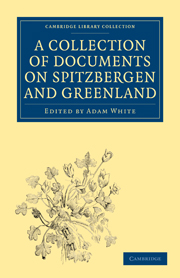 A Collection of Documents on Spitzbergen and Greenland
A Collection of Documents on Spitzbergen and Greenland Book contents
- Frontmatter
- INTRODUCTION
- PART THE FIRST VOYAGE INTO SPITZBERGEN AND GREENLAND
- PART THE SECOND CONTAINING THE DESCRIPTION OF SPITZBERGEN
- PART THE THIRD
- CHAP. I Of the Plants of Spitzbergen
- CHAP. II Of a Plant with Aloe-Leaves
- CHAP. III Of small House-Leek
- CHAPTER IV Of Crow's-Foot
- CHAP. V Of Scurvy-grass
- CHAP. VI Of an Herb like Stone-Crap
- CHAPTER VII Of a Snake-weed
- CHAP. VIII Of an Herb like unto Mouse-ear
- CHAP. IX Of a plant like unto Periwinkle
- CHAP. X Of an Herb like a Strawberry
- CHAP. XI Of the Rock Plant
- PART THE FOURTH OF THE ANIMALS OF SPITZBERGEN
- LIST OF THE ANIMALS OF SPITZBERGEN
- DESCRIPTION OF GREENLAND
- INDEX
- Plate section
CHAP. II - Of a Plant with Aloe-Leaves
Published online by Cambridge University Press: 05 June 2011
- Frontmatter
- INTRODUCTION
- PART THE FIRST VOYAGE INTO SPITZBERGEN AND GREENLAND
- PART THE SECOND CONTAINING THE DESCRIPTION OF SPITZBERGEN
- PART THE THIRD
- CHAP. I Of the Plants of Spitzbergen
- CHAP. II Of a Plant with Aloe-Leaves
- CHAP. III Of small House-Leek
- CHAPTER IV Of Crow's-Foot
- CHAP. V Of Scurvy-grass
- CHAP. VI Of an Herb like Stone-Crap
- CHAPTER VII Of a Snake-weed
- CHAP. VIII Of an Herb like unto Mouse-ear
- CHAP. IX Of a plant like unto Periwinkle
- CHAP. X Of an Herb like a Strawberry
- CHAP. XI Of the Rock Plant
- PART THE FOURTH OF THE ANIMALS OF SPITZBERGEN
- LIST OF THE ANIMALS OF SPITZBERGEN
- DESCRIPTION OF GREENLAND
- INDEX
- Plate section
Summary
It is a very pretty herb, and puts forth thick prickly and sad green leaves, like those of aloes; a brown naked stalk, about half the length of your finger, whereon hang round heads of flesh-coloured flowers in bunches, which are hardly to be discerned by the naked eye, one flower close above another, and near to another.
Sometimes two stalks shoot out of one plant, one bigger than the other. Yet each stalk has two of these bunches of flowers.
I could not delineate its seed for want of time. The root consists of many small fibres. We gathered it in great plenty on the 17th of July, behind the cookery of Harlem, in the running water. I know not well to what kind this may be referred. Caspar Bauhin maketh mention of an herb in his Prodronius of his Amphitheater of plants in the 5th book and 15th chapter, which he calls Limonium Maritimum, which he describeth with small, roundish, and thick leaves, like house-leek, between which spread small stalks with pale red flowers; but the root doth not agree with our plant, for his is long, red and parted at top, whereas this root consists in many small fibers, and is not red.
- Type
- Chapter
- Information
- A Collection of Documents on Spitzbergen and GreenlandComprising a Translation from F. Martens' Voyage to Spitzbergen, a Translation from Isaac de La Peyrère's Histoire du Groenland, and God's Power and Providence in the Preservation of Eight Men, pp. 46 - 47Publisher: Cambridge University PressPrint publication year: 2010First published in: 1855


